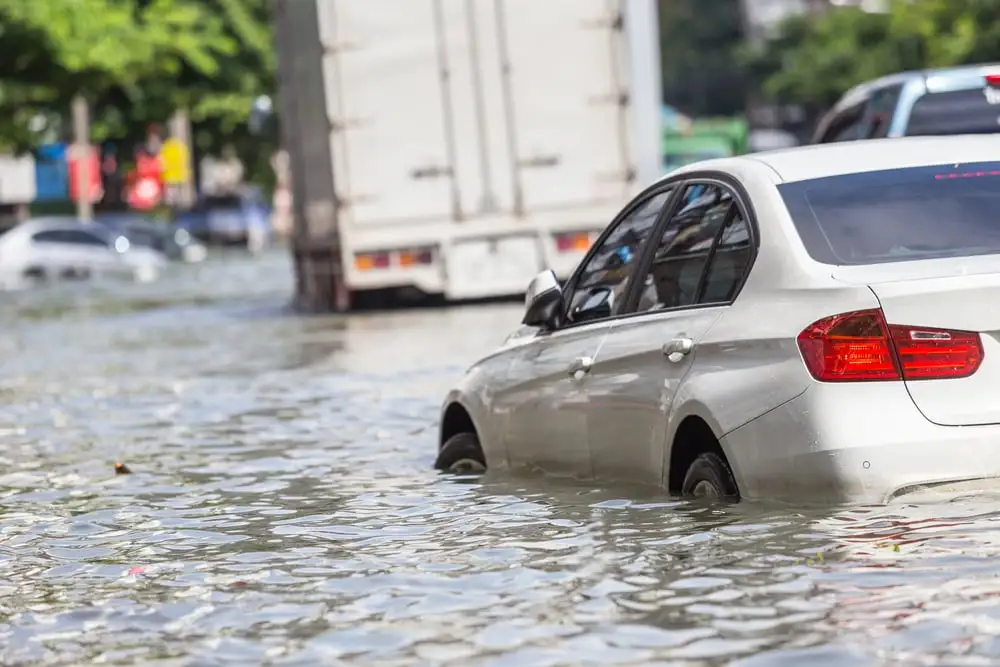Drivers are at risk when driving on flooded roads, which can create dangerous conditions and even be life-threatening.
Navigation through flood-prone areas is a complex process that requires careful planning and informed decisions.
Understanding the Dangers of Flooded Roads
Heavy rains, snowmelt or storms can cause roads to flood. Drivers facing flood conditions must be aware of the dangers.
Risk of Hydroplaning
Hydroplaning is one of the main risks that come with flooding roads. When a layer builds between a car’s tires and the road, it can cause hydroplaning. The phenomenon is dangerous to drivers because it can occur at low speeds.
Unseen Hazards Beneath the Water
Under the surface of the water, there may be hidden dangers, like rocks or debris. The road could even have been damaged. Hidden hazards can damage a car and cause accidents.
Variable Water Depths
Drivers can have difficulty assessing the risks accurately because of the varying depth of water. It is possible that even water that appears to be shallow can present a risk because it could conceal a deeper depression.
Rapidly Changing Conditions
Conditions can quickly change on flooded roads. The water level can rise suddenly, increasing currents and the danger of blinding floods.
Immediate Actions When Confronted with a Flooded Road
To ensure both driver and passenger safety, you must take immediate action and be well-informed when encountering a flooded road. These steps will help you handle this difficult situation in a systematic way.

Assess the Depth of the Water
Assess the depth of water before attempting to drive on a road that is flooded. It is better to stay away from the area if it’s impossible to gauge the water depth. It is possible to be in danger even in relatively shallow water.
Determine the Flow of the Water
Assess the current of water if the road has been flooded. Rapid currents are a serious risk and can increase the chances of losing vehicle control. Do not drive in areas where water is flowing fast.
Turn around; Don’t Drown
On flooded roads, the adage “Turn around, don’t drown” is true. It is best to find an alternate route if you are unsure about the depth of a flood or its safety. One of the most common weather-related fatalities is driving through floodwaters.
Find Higher Ground
You should seek higher ground if you find yourself in floodwaters that are rising or in a situation where the flooding is getting worse while driving. Finding a place away from the flood area that is safe for your safety can be crucial.
Abandon the Vehicle if Necessary
It may be necessary, in extreme situations, to abandon your vehicle if the floodwaters are rising rapidly and escaping is impossible. Before moving to higher ground, ensure that you have gotten all of your passengers out safely. Even shallow floodwaters can contain strong currents.
Tips for Preventing Flooded Road Incidents
There are several strategies and preventive actions that can be taken by drivers to reduce the likelihood of being in a similar situation.
Weather forecasts
Check the weather and updates on road conditions regularly, particularly during times of storms or heavy rainfall. By staying informed, drivers can plan their routes better and avoid flooding-prone areas.
Know Your Surroundings
Familiarize yourself with the local topography, including flood zones. You can plan alternate routes and make informed decisions in adverse weather conditions by understanding potential trouble spots.
Obey Road Closure Signs
When flooding is predicted, authorities often shut down roads in advance. Be sure to obey all road closure signs and barricades. Driving on closed roads can be dangerous and have legal implications.
Choose high-ground routes.
Plan routes that will be less likely to flood. When heavy rain or floods occur, higher ground routes away from rivers or low-lying regions are safer.
Maintain Your Vehicle
Make sure your car is well maintained, particularly components that are water-resistant, like the air intake and exhaust system. Checking your vehicle regularly can identify any potential problems that could compromise its ability to cope with flooding conditions.
Carry Emergency Supplies
If you are stranded by flooding or bad weather and need emergency supplies, it is important to have them in your car. In an emergency, items such as blankets, first aid kits, non-perishable foods, flashlights and water can prove to be essential.
